TRADESTATION: Fractal Adaptive Moving Average
John Ehlers' article in this issue, "Fractal Adaptive Moving Averages,"
already presents some EasyLanguage code for an adaptive moving average.
This adaptive moving average is based on the fractal properties of a price
series.
We have converted Ehlers' code for this moving average into an EasyLanguage
function, so that it can be called from any indicator or strategy. The
function's name is "AdaptMovAvg_Fractal."
We have also adapted an existing strategy based on Bollinger Bands so
that it calls this new function. The revised Bollinger Band strategy is
called "FractalAMA Bands." It calls "AdaptMovAvg_Fractal" for both the
variance and band calculations.
Strategy: FractalAMA Bands
{ The IntrabarOrderGeneration attribute is set to false in this strategy because
strategy calculations depend on end-of-bar prices. }
[IntrabarOrderGeneration = false]
inputs:
Price( 0.5 * ( H + L ) ),
N( 16 ),
NumDevsUp( 2 ),
NumDevsDn( 2 ),
TrailAmt( 0.5 ),
BandColor( Yellow ),
DataType( 1 ) ; { pass in 1 if you are working with the entire population, and 2
if you are working with a sample and want the standard deviation
for the population }
variables:
Divisor( 0 ),
Mean( 0 ),
SumSqr( 0 ),
AvgDiff( 0 ),
FracStandardDev( 0 ),
LowerBand( 0 ),
UpperBand( 0 ),
TL_ID1( -1 ),
TL_ID2( -1 ) ;
// AvgDiff = 0 ;
Divisor = Iff( DataType = 1, N, N - 1 ) ;
if Divisor > 0 then
begin
Mean = AdaptMovAvg_Fractal( Price, N ) ;
SumSqr = 0 ;
for Value1 = 0 to N - 1
begin
SumSqr = SumSqr + Square( Price[Value1] - Mean ) ;
end ;
AvgDiff = SumSqr / Divisor ;
end ;
if AvgDiff > 0 then
FracStandardDev = SquareRoot( AvgDiff )
else
FracStandardDev = 0 ;
LowerBand = Mean - NumDevsDn * FracStandardDev ;
UpperBand = Mean + NumDevsUp * FracStandardDev ;
if CurrentBar > 1 and Low crosses over LowerBand then
{ CB > 1 check used to avoid spurious cross confirmation at CB = 1 }
Buy ( "BBandLE" ) next bar LowerBand stop ;
if CurrentBar > 1 and High crosses under UpperBand then
SellShort next bar at UpperBand Stop ; { ie, don't buy if next bar completely
below current LowerBand, but wait for
next crossing condition - an example of
a non-persistent setup with an
indefinite stop/limit trigger }
SetStopShare ;
SetDollarTrailing( TrailAmt ) ;
SetProfitTarget ( 3 * TrailAmt ) ;
{ Use trendlines to "plot" the bands on the chart }
TL_ID1 = TL_New( Date[1], Time[1], UpperBand[1], Date,
Time, UpperBand ) ;
TL_SetColor( TL_ID1, BandColor ) ;
TL_ID2 = TL_New( Date[1], Time[1], LowerBand[1], Date,
Time, LowerBand ) ;
TL_SetColor( TL_ID2, BandColor ) ;
Function: AdaptMovAvg_Fractal
inputs:
Price( NumericSeries ),
N( NumericSimple ) ; { N must be an even number }
variables:
N3( 0 ),
HH( 0 ),
LL( 0 ),
HalfN( 0 ),
Count( 0 ),
N1( 0 ),
N2( 0 ),
Dimen( 0 ),
Alpha( 0 ),
Filt( 0 ) ;
N3 = ( Highest( High, N ) - Lowest( Low, N ) ) / N ;
HH = High ;
LL = Low ;
HalfN = 0.5 * N ;
for Count = 0 to HalfN - 1
begin
if High[Count] > HH
then HH = High[Count] ;
if Low[Count] < LL then
LL = Low[Count] ;
end ;
N1 = ( HH - LL ) / HalfN ;
HH = High[HalfN] ;
LL = Low[HalfN] ;
for Count = HalfN to N - 1
begin
if High[Count] > HH then
HH = High[Count] ;
if Low[Count] < LL then
LL = Low[Count] ;
end ;
N2 = ( HH - LL ) / HalfN ;
if N1 > 0 and N2 > 0 and N3 > 0 then
Dimen = ( Log( N1 + N2 ) - Log( N3 ) ) / Log( 2 ) ;
Alpha = ExpValue( -4.6 * ( Dimen - 1 ) ) ;
if Alpha < 0.01 then
Alpha = 0.01
else if Alpha > 1 then
Alpha = 1 ;
Filt = Alpha * Price + ( 1 - Alpha ) * Filt[1] ;
if CurrentBar < N + 1 then
Filt = Price ;
AdaptMovAvg_Fractal = Filt ;
This code and function will be available for download from the Support
Center at TradeStation.com. Search for the file "Frama.eld." Ehlers' original
code can be found in the .eld file.
--Mark Mills
EasyLanguage Questions Forums
TradeStation Securities, Inc.
A subsidiary of TradeStation Group, Inc.
GO BACK
METASTOCK: Fractal Adaptive Moving Average
John Ehlers' article in this issue, "Fractal Adaptive Moving Averages,"
introduces an indicator of the same name. In his indicator formula, he
restricts the number of periods to an even number. The formula in MetaStock
avoids this restriction by asking for the smaller time frame. This number
is then used for the two half-interval calculations and is then doubled
for the full interval calculation. The formula for this indicator and the
steps to include it in MetaStock are presented here.
To enter this indicator into MetaStock:
1. In the Tools menu, select Indicator Builder.
2. Click New to open the Indicator Editor for a new indicator.
3. Type the name of the formula.
4. Click in the larger window and input the following formula:
Name: FRAMA
Formula:
y:=Input("sample time periods",1,20,8);
y2:=2*y;
n1:=(HHV(H,y)-LLV(L,y))/y;
n2:=Ref((HHV(H,y)-LLV(L,y))/y,-y);
n3:=(HHV(H,y2)-LLV(L,y2))/y2;
x:=(Log(n1+n2)-Log(n3))/Log(2);
xt:=Exp(-4.6*(x-1));
x1:=If(xt<0.1,0.1,If(xt>1,1,xt));
x2:=1-x1;
If(Cum(1)=y2,
(MP() * x1) + (Ref(MP(),-1) * x2),
(MP() * x1) + (PREV * x2))
--William Golson, Equis International
www.equis.com
GO BACK
AIQ EXPERT DESIGN STUDIO: Fractal Adaptive
Moving Average
The AIQ code for John Ehlers' fractal adaptive moving average (FRAMA)
is shown here together with two sample trading systems that we used in
a backtest to determine if the FRAMA is an improvement over a fixed-period
exponential moving average.
A value of N=40 was used to run the FRAMA test. The exponential average
test was run using a fixed period of 40 days. The systems buy when the
price crosses above the moving average and sell when the price crosses
below the moving average. Only the long side was tested.
Figure 1 shows a comparison of a FRAMA with N=40 to an exponential moving
average for 40 days. The FRAMA is more responsive to price changes than
the exponential moving average. The backtest results shown in Figure 2,
which were run on the NASDAQ 100 list of stocks, show that the FRAMA is
an improvement over the exponential moving average for the sample trading
system tested.
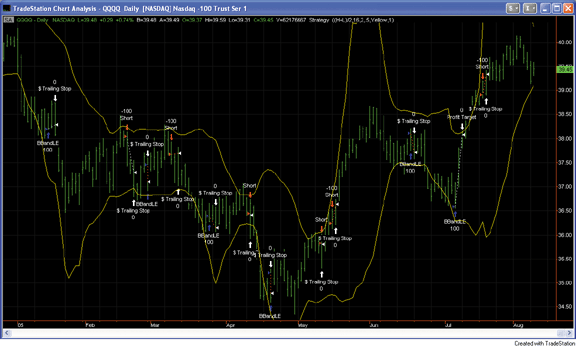
FIGURE 1: TRADESTATION, QQQQ. Here's a sample TradeStation
daily bar chart demonstrating the fractal adaptive moving average. For
clarity's sake, the FRAMA indicator line is not shown.
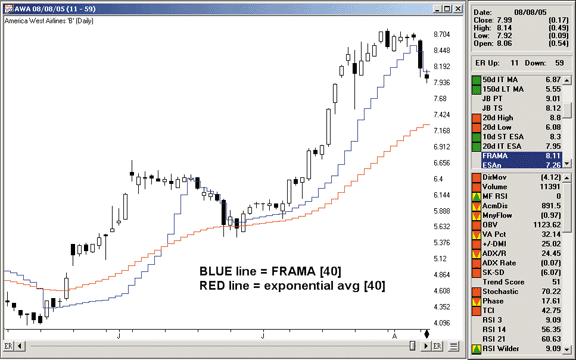
FIGURE 2: AIQ EXPERT DESIGN STUDIO, FRAMA. Here is a comparison
of FRAMA with N=40 to an exponential moving average for 40 days. The FRAMA
appears to be more responsive to price changes than the exponential moving
average.
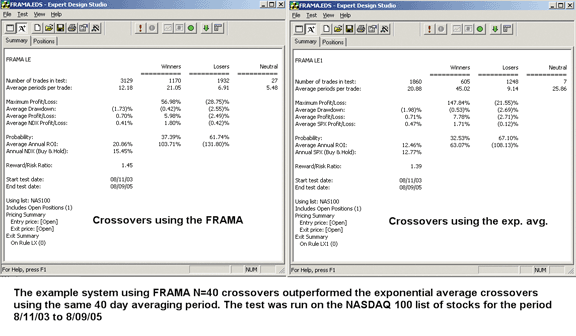
FIGURE 3: AIQ EXPERT DESIGN STUDIO, BACKTEST RESULTS FOR FRAMA.
The backtest results based on the NASDAQ 100 list of stocks show that
the FRAMA is an improvement over the exponential moving average for this
sample trading system.
The AIQ code is shown here but can also be downloaded from www.aiqsystems.com/S&C1.htm.
!! FRAMA Fractal Adaptive Moving Average
!! Author: John Ehlers
!! Coded by Richard Denning 8/9/05
!CODING ABREVIATIONS:
H is [high].
L is [low].
C is [close].
O is [open].
Price is (H+L)/2.
Define N 40. !MUST BE AN EVEN NUMBER
N3 is (highresult(H,N,0) - lowresult(L,N,0)) / N.
N1 is (highresult(H,N / 2 - 1,0)
- lowresult(L,N / 2 - 1,0)) / (N / 2).
N2 is (highresult(H,N / 2,N / 2 - 1)
- lowresult(L,N / 2,N / 2 - 1)) / (N / 2).
Dimen is iff(N1 > 0 and N2 > 0
and N3 > 0,(ln(N1 + N2) - ln(N3)) / ln(2),0).
Alpha1 is Exp(-4.6 * (Dimen - 1)).
Alpha is iff(Alpha1 < 0.01,0.01,iff(Alpha1 > 1,1,Alpha1)).
Days is ReportDate() - RuleDate().
Stop if Days > N + 2.
Stopesa is iff(stop,Price, FILT).
FILT is iff(ReportDate() - FirstDataDate() < N + 1,Price,
Alpha * price + (1 - Alpha) * valresult(Stopesa, 1 )).
ESAn is expavg(Price,N).
List if 1.
!EXAMPLE SYSTEM USING FRAMA:
LE if Price > FILT and valrule(Price < FILT,1).
LX if Price < FILT and valrule(Price > FILT,1).
!EXAMPLE SYSTEM USING EXPONENTIAL MOVING AVG:
LE1 if Price > ESAn and valrule(Price < ESAn,1).
LX1 if Price < ESAn and valrule(Price > ESAn,1).
--Richard Denning
richard.denning@earthlink.net
www.aiqsystems.com
GO BACK
WEALTH-LAB: Fractal Adaptive Moving Average
In this month's Traders' Tips, we present a trend-following system based
on the fractal adaptive moving average (FRAMA) indicator introduced by
John Ehlers in his article this issue. Wealth-Lab's implementation of the
FRAMA custom indicator (now part of the Wealth-Lab code library) allows
inputs for the period as well as the constant for the exponential moving
average. Here, we use the constant 4.6, as Ehlers suggests.
The system uses the 20-day FRAMA of the closing price and also calculates
the rate of change (ROC) of the past five days of FRAMA. It then waits
for an increase of more than 0.5% (ROC > 0.5) to enter the next day at
the market. It stays in this trade until the ROC falls below zero.
In Figure 4, which shows a sample trade for ExxonMobil, we can see that
the FRAMA indicator is mostly flat in sideways phases while it is able
to detect a trend very early, thus catching a big part of it.
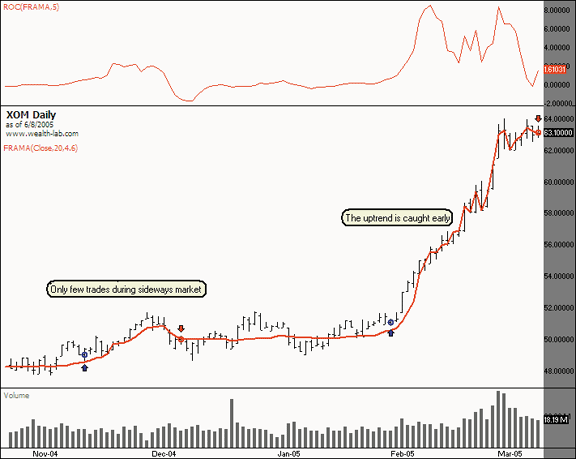
FIGURE 4: WEALTH-LAB, FRACTAL ADAPTIVE MOVING AVERAGES.
The ExxonMobil price series together with its 20-day FRAMA is plotted
in the lower pane. The upper pane shows the rate of change (ROC) of five
days of the FRAMA indicator. During sideways phases, the FRAMA indicator
shows only little movement. Consequently, the ROC shows small values and
only few trades occur. At the end of January 2005, a strong uptrend starts,
which is detected by the FRAMA. The system is able to enter early and catches
most of this upmove.
WealthScript Code:
{$I 'FRAMA'}
var Bar, ROCPane: integer;
var F:integer = FRAMASeries(#Close, 20, 4.6);
var R:integer = ROCSeries(F, 5);
PlotSeriesLabel(F, 0, #red, #thick, 'FRAMA(Close,20,4.6)');
ROCPane:=CreatePane(75,true,true);
PlotSeriesLabel(R, ROCPane, #red, #thin,'ROC(FRAMA,5)');
for Bar := 20 to BarCount - 1 do
begin
if not LastPositionActive then
begin
if @R[Bar] > 0.5 then BuyAtMarket(Bar+1, 'entry signal');
end
else
begin
if @R[Bar] < 0 then SellAtMarket(Bar+1, LastPosition, 'exit signal');
end;
end;
-- José Cruset, Wealth-Lab, Inc.
www.wealth-lab.com
GO BACK
eSIGNAL: Fractal Adaptive Moving Average
For this issue's article by John Ehlers, "Fractal Adaptive Moving Averages,"
we've provided the eSignal formula file named "Frama.efs." The code is
also displayed here.
The study has one parameter for the length, or periods, for the study
that may be adjusted through the "Edit Studies" option of the Advanced
Chart. The number entered will be forced to be the next highest even number
if an odd number is entered. A sample eSignal chart is shown in Figure
5.
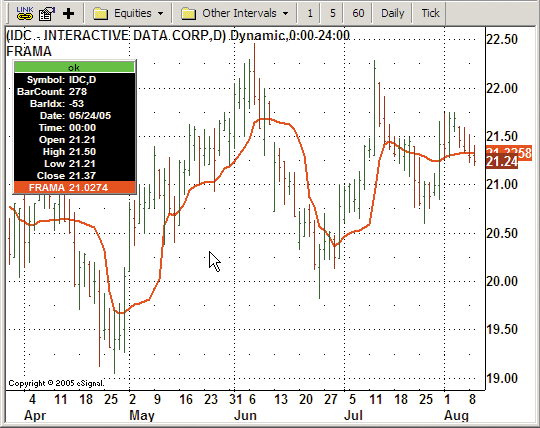
FIGURE 5: eSIGNAL, FRACTAL ADAPTIVE MOVING AVERAGE. This
eSignal chart demonstrates the fractal adaptive moving average.
/***************************************
Provided By : eSignal (c) Copyright 2005
Description: Fractal Adaptive Moving Average - by John Ehlers
Version 1.0 8/9/2005
Notes:
October 2005 Issue - "FRAMA - Fractal Adaptive Moving Average"
* Study requires version 7.9 or higher.
* Length will be forced to be an even number. Odd numbers will be bumped up to the
next even number.
Formula Parameters: Defaults:
Length 16
***************************************/
function preMain() {
setPriceStudy(true);
setStudyTitle("FRAMA ");
setShowTitleParameters(false);
setCursorLabelName("FRAMA", 0);
setDefaultBarFgColor(Color.red, 0);
setDefaultBarThickness(2, 0);
var fp1 = new FunctionParameter("nLength", FunctionParameter.NUMBER);
fp1.setName("Length");
fp1.setDefault(16);
fp1.setLowerLimit(1);
}
var bVersion = null;
var Filt = null;
var Filt_1 = null; //previous bar's Filt
function main(nLength) {
if (bVersion == null) bVersion = verify();
if (bVersion == false) return;
var nState = getBarState();
if (nState == BARSTATE_NEWBAR) {
Filt_1 = Filt;
}
var N = Math.round(nLength/2) * 2; // forces N to be even number
var Price = hl2();
var count = 0;
var N1 = 0;
var N2 = 0;
var N3 = (highest(N, high()) - lowest(N, low())) / N;
var HH = high(0);
var LL = low(0);
var Dimen = 0;
var alpha = 0;
Filt = 0;
if (Filt_1 == null) Filt_1 = 0;
for( count = 0; count <= (N/2 -1); count++) {
if (high(-count) > HH) HH = high(-count);
if (low(-count) < LL) LL = low(-count);
}
N1 = (HH - LL) / (N / 2);
HH = high(-(N/2));
LL = low(-(N/2));
for (count = (N/2); count <= (N-1); count++) {
if (high(-count) > HH) HH = high(-count);
if (low(-count) < LL) LL = low(-count);
}
N2 = (HH - LL) / (N / 2);
if (N1 > 0 && N2 > 0 && N3 > 0) {
Dimen = (Math.log(N1 + N2) - Math.log(N3)) / Math.log(2);
}
alpha = Math.exp(-4.6*(Dimen - 1));
if (alpha < 0.01) alpha = 0.01;
if (alpha > 1) alpha = 1;
Filt = (alpha*Price) + (1 - alpha)*Filt_1;
if (getCurrentBarCount() < N) Filt = Price;
return Filt;
}
/***** Support Functions *****/
function verify() {
var b = false;
if (getBuildNumber() < 700) {
drawTextAbsolute(5, 35, "This study requires version 7.9 or later.", Color.white,
Color.blue, Text.RELATIVETOBOTTOM|Text.RELATIVETOLEFT|Text.BOLD|Text.LEFT,
null, 13, "error");
drawTextAbsolute(5, 20, "Click HERE to
upgrade.@URL=https://www.esignal.com/download/default.asp", Color.white, Color.blue,
Text.RELATIVETOBOTTOM|Text.RELATIVETOLEFT|Text.BOLD|Text.LEFT, null, 13, "upgrade");
return b;
} else {
b = true;
}
return b;
}
To discuss this study or download a complete copy of the formula,
please visit the Efs Library Discussion Board forum under the Bulletin
Boards link at www.esignalcentral.com. This eSignal formula code is also
available for copying and pasting from the STOCKS & COMMODITIES website
at Traders.com.
--Jason Keck
eSignal, a division of Interactive Data Corp.
800 815-8256, www.esignal.com
GO BACK
NEUROSHELL TRADER: Fractal Adaptive Moving
Average
The fractal adaptive moving average introduced by John Ehlers in this
issue can be easily implemented in NeuroShell Trader by combining a few
of NeuroShell Trader's 800+ indicators and one custom indicator, which
in itself is a very useful generic adaptive moving average.
To implement the fractal adaptive moving average, select "New Indicator
..." from the Insert menu and use the Indicator Wizard to create the following
indicators:
N3: Divide( Subtract( PriceRange( High, Low, n ), n )
N1: Divide( Subtract( PriceRange( High, Low, n/2 ), n/2 )
N2: Lag( N1, n/2 )
Dimen : Divide( Subtract( Log( Add2( N1, N2 ), Log(N3), Log(2) )
Alpha: Min2( Max2( Exp ( Multiply ( -4.6, Subtract ( Dimen, 1 ) ) ), .01), 1 )
Filt: AdaptiveExpAvg* ( Avg2( High, Low ), Alpha )
Users of NeuroShell Trader can go to the STOCKS & COMMODITIES section
of the NeuroShell Trader free technical support website to download custom
indicators and a sample chart (Figure 6).
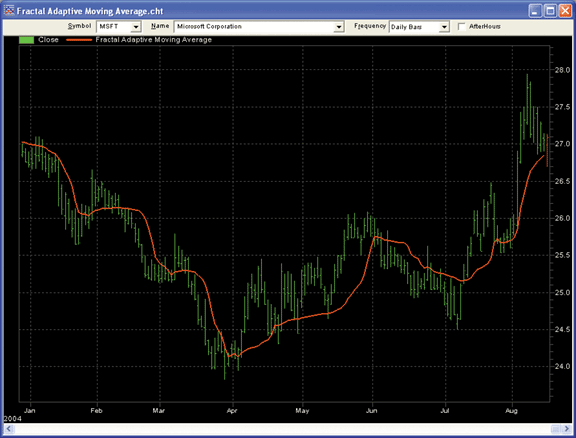
FIGURE 6: NEUROSHELL TRADER, FRAMA. Here's a sample
NeuroShell Trader chart demonstrating the fractal adaptive moving average.
For more information on NeuroShell Trader, visit www.NeuroShell.com.
--Marge Sherald, Ward Systems Group, Inc.
301 662-7950, sales@wardsystems.com
www.neuroshell.com
GO BACK
AMIBROKER: Fractal Adaptive Moving Average
In "Fractal Adaptive Moving Averages," John Ehlers presents a new method
of adaptive smoothing based on the assumption that market prices are fractal.
Coding the fractal adaptive moving average (FRAMA) is relatively straightforward
in AmiBroker Formula Language (AFL). Thanks to its powerful array-processing
functions, FRAMA can be implemented in AmiBroker without any loops, making
it extremely fast.
Ready-to-use code is presented in Listing 1. For comparison purposes,
the code also plots a standard exponential moving average of the same length
(Figure 7).
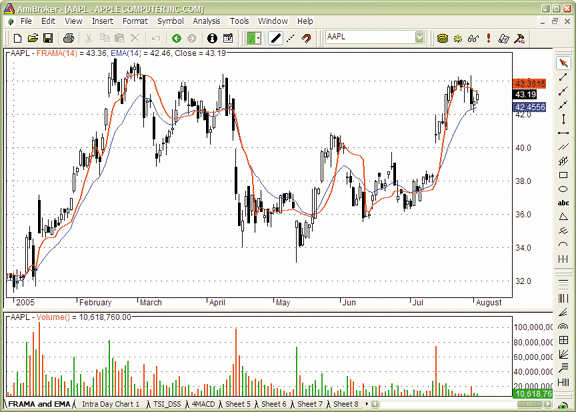
FIGURE 7: AMIBROKER, FRACTAL ADAPTIVE MOVING AVERAGE. This AmiBroker
screenshot shows a price chart of AAPL with a 14-day FRAMA (red line) and
exponential moving average (blue line) of the same length. FRAMA follows
significant changes in price more rapidly, while maintaining smoothness
in congestion zones.
LISTING 1
// FRAMA - Fractal Adaptive Moving Average
Price = (H+L)/2;
N = Param( "N", 16, 2, 40, 2 ); // must be even
N3 = ( HHV( High, N ) - LLV( Low, N ) ) / N;
HH = HHV( High, N / 2 ) ;
LL = LLV( Low, N / 2 );
N1 = ( HH - LL ) / ( N / 2 );
HH = HHV( Ref( High, - N/2 ), N/2 );
LL = LLV( Ref( Low, - N/2 ), N/ 2 );
N2 = ( HH - LL ) / ( N / 2 );
Dimen = IIf( N1 > 0 AND N2 > 0 AND N3 > 0, ( log( N1+N2) - log( N3 )
)/log( 2 ), Null );
alpha = exp( -4.6 * (Dimen -1 ) );
alpha = Min( Max( alpha, 0.01 ), 1 ); // bound to 0.01...1 range
Frama = AMA( Price, alpha );
Plot( Frama, "FRAMA("+N+")", colorRed, styleThick );
Plot( EMA( C, N ) , "EMA("+N+")", colorBlue );
Plot( C, "Close", colorBlack, styleCandle );
A downloadable version of the formula is available from Amibroker.com
website.
--Tomasz Janeczko, AmiBroker.com
www.amibroker.com
GO BACK
NEOTICKER: Fractal Adaptive Moving Average
The fractal adaptive moving average (FRAMA) computation presented in
the article "Fractal Adaptive Moving Averages" by John Ehlers can be implemented
as a NeoTicker indicator. Listing 1 shows the code for the fractal adaptive
moving average indicator, with two parameters. The first parameter is price,
which is a formula parameter that uses the average price calculation as
the default. The second parameter is N, which is an integer parameter with
16 as the default.
The NeoTicker fractal adaptive moving average indicator plots a line
that connects the calculation result of a fractal average for each bar.
This indicator, like any other indicator, can be used in a trading system,
as shown in the sample chart in Figure 8, where a crossover system is constructed
using FRAMA.
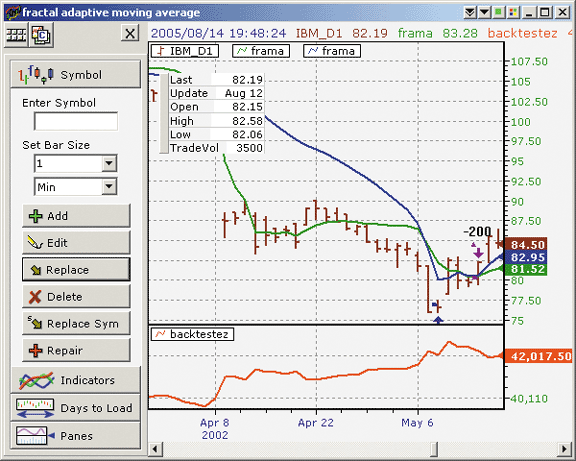
FIGURE 8: NEOTICKER, FRACTAL ADAPTIVE MOVING AVERAGE. Here's
a sample NeoTicker chart showing a crossover system constructed using the
FRAMA indicator.
A downloadable version of this indicator and sample chart will be
available at the NeoTicker Yahoo! User Group.
LISTING 1
function frama()
Const Filt = 0
N = 1
dim myhhv, myllv, myprice
myhhv = itself.makeindicator ("hhv1", "hhv", Array("1.h"), _
Array(params("N").str))
myllv = itself.makeindicator ("llv1", "llv", Array("1.l"), _
Array(params("N").str))
myprice = itself.makeindicator ("price1", "fml", Array("1"), _
Array(params("Price").str))
if heap.size = 0 then
heap.allocate(2)
heap.value(Filt) = 0
heap.value(N) = params("N").int
end if
if data1.barsnum(0) < (heap.value(N)+1) then
itself.success = false
heap.value(Filt) = myprice.value(0)
exit function
end if
if (heap.value(N) mod 2) <> 0 then
ntlib.debug("N must be even number, calculation abort")
itself.success = false
exit function
end if
N3 = (myhhv.value(0)-myllv.value(0))/heap.value(N)
HH = data1.high(0)
LL = data1.low(0)
for i=0 to heap.value(N)/2-1
if data1.high(i) > HH then
HH = data1.high(i)
end if
if data1.low(i) < LL then
LL = data1.low(i)
end if
next
N1 = (HH-LL)/(heap.value(N)/2)
HH = data1.high(heap.value(N)/2)
LL = data1.low(heap.value(N)/2)
for i=heap.value(N)/2 to heap.value(N)-1
if data1.high(i) > HH then
HH = data1.high(i)
end if
if data1.low(i) < LL then
LL = data1.low(i)
end if
next
N2 = (HH-LL)/(heap.value(N)/2)
if N1>0 and N2>0 and N3>0 then
Dimen = (ntlib.ln(N1+N2) - ntlib.ln(N3))/ntlib.ln(2)
alpha = ntlib.exp(-4.6*(Dimen-1))
end if
if alpha<0.01 then alpha = 0.01
if alpha>1 then alpha = 1
frama = alpha*myprice.value(0)+(1-alpha)*heap.value(Filt)
heap.value(Filt) = frama
end function
--Kenneth Yuen, TickQuest Inc.
www.tickquest.com
GO BACK
TRADINGSOLUTIONS: Fractal Adaptive Moving
Average
In his article "Fractal Adaptive Moving Averages," John Ehlers describes
an exponential moving average based on recent volatility, using fractal
dimensions of recent prices to establish an alpha.
This code can be entered into TradingSolutions as follows:
Name: FRAMA Boxes
Inputs: High, Low, Period, Maximum Period
Div (Sub (HighestVL (High, Period, Maximum Period), LowestVL (Low, Period,
Maximum Period)), Period)
Name: FRAMA Dimension
Inputs: High, Low, Period
Div (Sub (Log10 (Add (FRAMABoxes (High, Low, Div (Period, 2),Period), LagVL
(FRAMABoxes (High, Low, Div (Period, 2), Period),Div (Period, 2), Period))),
Log10 (FRAMABoxes (High, Low, Ident (Period), Period))), Log10 (2))
Name: FRAMA Alpha
Inputs: High, Low, Period
Max (Min (Exp (Mult (-4.6, Sub (FRAMADimension (High, Low, Period),1))),1),0.01)
Name: FRAMA
Inputs: High, Low, Period
EMA%% (Avg (High, Low), FRAMAAlpha (High, Low, Period))
This function is also available as a downloadable file from the
TradingSolutions website (www.tradingsolutions.com) in the Solution Library
section. As with many indicators, this function could make a good input
to neural network predictions.
--Gary Geniesse, NeuroDimension, Inc.
800 634-3327, 352 377-5144
www.tradingsolutions.com
GO BACK
FINANCIAL DATA CALCULATOR: Fractal Adaptive
Moving Average
The article "Fractal Adaptive Moving Averages" by John Ehlers shows
how to use a fractal dimension approximation to make an exponential moving
average adaptive. In Financial Data Calculator (FDC), this is most easily
done using three macros:
1. boxcount:
@ boxcount computes the boxcount each day for
@John Ehlers' Fractal Adaptive Moving Average
@syntax is 'n boxcount dataset' (n even)
N: #L
DS: #R
HH: N MOVMAX HIGH DS
LL: N MOVMIN LOW DS
(HH-LL)/N
Example: 10 BOXCOUNT IBM
2. fracdim:
@fracdim computes the fractal dimension each day
@for John Ehlers' Fractal Adaptive Moving Average
@syntax is 'n fracdim dataset' (n even)
N: #L
DS: #R
N3: N BOXCOUNT DS
N2: (N/2) BOXCOUNT DS
N1: (N/2) BOXCOUNT DS BACK N/2
((LOG (N1 + N2)) -LOG N3)/LOG 2
Example: 10 FRACDIM IBM
3. frama:
@John Ehlers' Fractal Adaptive Moving Average
@syntax is 'n frama dataset'
N: #L
DS: #R
H: HIGH DS
L: LOW DS
ALPHA: EXP (-4.6 * (-1 + N FRACDIM DS ))
ALPHA EXPAVE (H + L)/2
Example: 10 FRAMA IBM
--Bill Rafter
Mathematical Investment Decisions Inc.
856 857-9088, mathinvestdecisions.com
TRADESTATION: Fractal Adaptive Moving Average
METASTOCK: Fractal Adaptive Moving Average
AIQ EXPERT DESIGN STUDIO: Fractal Adaptive Moving Average
WEALTH-LAB: Fractal Adaptive Moving Average
eSIGNAL: Fractal Adaptive Moving Average
NEUROSHELL TRADER: Fractal Adaptive Moving Average
AMIBROKER: Fractal Adaptive Moving Average
NEOTICKER: Fractal Adaptive Moving Average
TRADINGSOLUTIONS: Fractal Adaptive Moving Average
FINANCIAL DATA CALCULATOR: Fractal Adaptive Moving Average







